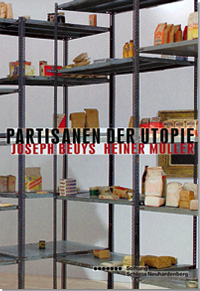 |
||
|
||
Joseph
Beuys – Heiner Müller: German out of print |
Joseph Beuys (1921–1986) and Heiner Müller (1929–1995) never actually met. They have nonetheless had their encounters – if only in spirit. An imaginary dialogue between the two artists is presented in Partisans for utopia, an exhibition commemorating Heiner Müller’s 75th birthday which has been curated by Carsten and Gerhard Ahrens for the Stiftung Schloss Neuhardenberg. The book records this dialogue, thereby creating the venue for an encounter between two artists who both illuminate the condition of the world in the future light of its changeability. The active commitment of Beuys’s art as the alternative vision of a “third way” beyond capitalism and communism is echoed in Müller’s radical critique of social relations in East and West. In a constant oscillation between close and distant focus, the confrontation of words and works outlines the picture of artistic elected affinities whose orientation towards the utopia of a different world is its common vanishing point. As a lateral measure, so to speak, Jonathan Meese presents his combative vision of a state model as an homage to Heiner Müller which culminates in an assertion of faith in the subversive energy of the artistic partisan. With numerous selected texts by Beuys and Müller the book explores how two distinct realms of thinking are intermeshed, two worlds which artistically formulate an alternative beyond ideological programmes. The comprehensive photographic documentation of the exhibition mirrors the multifaceted parallels between these two bodies of artistic work, whose visionary radicality has lost none of its relevance up to the present day.
... |